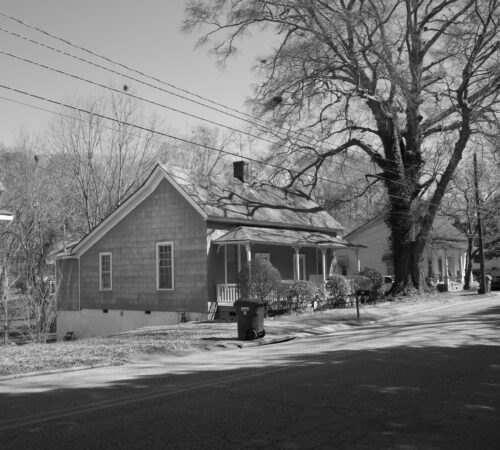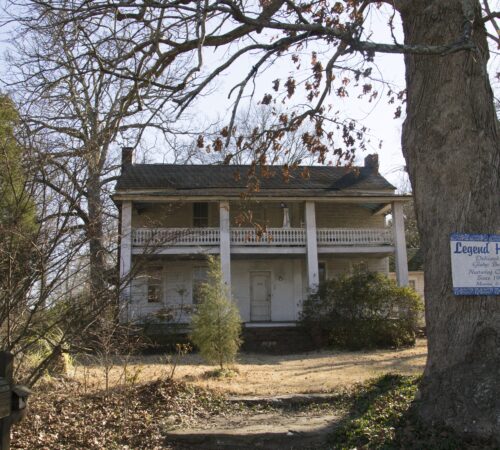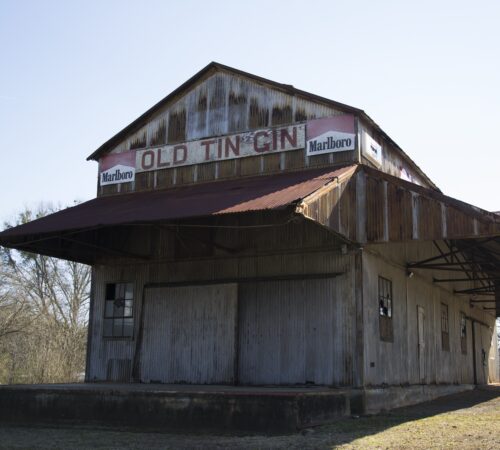The textile industry in this community began earlier than many others and grew quickly.
The city of Newnan was already an established industrial center before the textile industry appeared in 1888. Beginning with cotton, Newnan’s textile industry diversified by adding a hosiery mill in 1926. Soon after Newnan participated in the General Textile Strike of 1934. The cotton and hosiery mills operated until the 1990s when they faced international competition.
Visit
Things to Do
- McRitchie-Hollis Museum, 74 Jackson Street: Located in Newnan, this home was built by Arnall Mills’ president Ellis H. Peniston and his wife Mildred Willcoxon Arnall Peniston in 1937. Now home to the Newnan-Coweta Historical Society’s McRitchie-Hollis Museum, the museum hosts exhibitions and shares stories of the textile industry. For more information visit newnancowetahistoricalsociety.com.
- Newnan-Coweta Historical Society’s Depot History Center, 60 East Broad Street: This historic depot was built in the 1890s to serve passengers as well as freight. The depot is now operated by the Newnan-Coweta County Historical Society and can be toured by appointment. While you’re there pick up a “City of Homes” driving tour brochure to see Newnan’s historic homes!
- The Coweta County African American Heritage Museum, 92 Farmer Street: The African American Heritage Museum & Research Center provides a repository for African-American artifacts and records while also serving as a genealogy workroom for African-American research. Adjacent to the museum, which is housed in a restored shotgun-style house, is the Farmer Street Cemetery which is one of the largest slave cemeteries in the South. The museum is open on Wednesdays from 10 a.m. to 4 p.m.
- “City of Homes” Historic Homes Tour: Pick up a self-guided driving tour brochure from the Coweta County Convention & Visitors Bureau located at 200 Court Square in Newnan’s historic courthouse. The tour provides a nice stroll through Newnan’s downtown area and includes fifty historic homes. The visitor’s bureau is open Monday through Friday from 9 a. m. to 5 p.m. and Saturday from 9 a.m. to 4 p.m.
Places to See
The following properties are not open to the public, but you can view them from the exterior to learn more about the buildings that supported the textile industry here.
- Newnan Cotton Mill No. 1 and Mill Village, 110 Field Street: This mill has been transformed into Newnan Lofts. The building and the surrounding mill village are both listed on the National Register of Historic Places. Drive down East Washington Street past Robinson Street to see the mill village, homes built by the mill owners to house their employees.
- Newnan Square, 100 Court Square: The first official land sale in Newnan which took place in 1829, resulted in the construction of this small town square, featuring a log cabin and a small store. With the rise of the textile industry, the square served as a hub of trade and home to several textile-related businesses, including Newnan Hosiery Mill and the Manget-Brannon Company. Indeed, a building occupied by Newnan Hosiery Mill can be viewed from the road at the corner of Spring and LaGrange Streets. The building is brick, painted white, and features distinctive Palladian-style windows on the second floor. It currently houses several local businesses. Historic photos from the 1890s show the square full of horse-drawn carriages loaded with cotton coming from the country to sell in the city markets. The original 1829 courthouse, which has been remodeled several times, remains in its original location at the center of the square. Over the decades, the square continues to serve as a space for social gathering and home to many local businesses.
- International Playtex Corporation, 320 Temple Avenue: In 1954, this company opened its Sewn Products Division, northwest of the town square. Playtex was among the companies that took over the textile industry in Newnan in the 1960s. Making bras and a line of baby pants and bibs, the plant employed mostly white women from the area. By the late 1990s, most textile mills across the nation closed due to increased foreign competition with Asia, and this company closed its doors here in 1999.
- Manget-Brannon Company, 24 1st Avenue: Founded in 1918 as the Manget Brothers Company grocery store. Later, the company shifted its concentration to the cotton brokerage trade remaining in the business until 1962. The old Manget-Brannon Company cotton warehouse now provides space for retail business and charities including the Bridging the Gap Community Outreach.
- McIntosh Mill and Mill Village, Jefferson Street: This mill has since been demolished. Located at the intersection of Sprayberry and Jefferson Streets, this village is an example of the type of housing provided to mill employees in the early twentieth century.
- Newnan Cotton Mill No. 2 and Mill Village, 94 East Newnan Road: This mill has been largely demolished and the site is fairly overgrown, although the foundations and a few outbuildings might still be visible. The mill village is still standing, it makes up a sizable portion of East Newnan. The village is centered on East Newnan Road stretching down from Freeman Street to Cole Street. Two clusters of houses are based between Freeman and Front Street and Hill and East Murphy Streets respectively.
- Newnan Hosiery Mills Inc./Mann’s Hosiery Mill, 17 Augusta Drive: This was an important employer in the area until closing in 1950. This property is currently vacant and for sale.
History
The booming county seat of Newnan had already become a leading commercial center and a railroad hub by 1888, when local investors established the Newnan Cotton Mill. The company added a second mill, the East Newnan Cotton Mill, in 1901. Both mills specialized in the production of mixed fibers. During the construction of the first mill, the company added a dozen saddlebag homes nearby to house the mill employees, and additional homes were built in 1905. By the 1920s, this mill employed nine hundred workers, both white and African American, to produce weaving and specialty twist yarn.
Keeping up with the New South trend of the 1920s, Newnan’s textile industry diversified with the opening of the Newnan Hosiery Mills in 1926. Also known as, Mann’s Mill, the hosiery mill manufactured socks and at its height employed up to three hundred and fifty local workers. The mill closed in 1950. The International Playtex Corporation opened its Sewn Products Division in the former Newnan Hosiery Mill Building in 1954. By 1965, this plant employed six hundred people locally. In 1991, the Playtex Corporation was purchased by the Sara Lee Corporation, which shut down operations in Newnan in 1999 when the company reorganized.
Newnan is also well known for its involvement in the General Textile Strike of 1934, since the first strikers to be arrested worked in East Newnan Cotton Mills and nearby Arnall Mills in Sargent. The Georgia National Guard and local civil authorities arrested the picketers, inspected them for weapons, and transported them in military trucks to Fort McPherson outside Atlanta. The National Guard kept the strikers in outdoor detention facilities built for World War II prisoners until the strike ended three weeks later. Afterward, some workers were blacklisted and forced out of company homes because of their participation. Atlanta Constitution photographer Kenneth Waters documented the strike, and his photographs are available at the Atlanta History Center.
During World War II, the Newnan Cotton Mill received the Army-Navy award for excellence in war production. By 1950, the Newnan Cotton Mill and East Newnan Mill employed over one thousand workers and were pioneers in the field of blended fabrics used for a variety of products, including men’s suits and overcoats and women’s dresses and hats. Over the next two decades, however, a series of national companies purchased the plant, including Mt. Vernon Mills, West-Point Pepperell, and Bibb Manufacturing. Operations ceased in 1970.
Facing increasing foreign competition from Asia, the remaining textile mills in Newnan closed in the late 1990s. Fortunately, remnants of Newnan’s rich textile history are still around. In 2001, the Newnan Cotton Mills buildings were rehabilitated into Newnan Lofts, a mixed-use development now listed on the National Register of Historic Places. Drive down E. Washington Street past Robinson Street to see the Newnan Cotton Mills’ mill village, homes built by the mill owners to house their employees. The former Manget-Brannon Company’s cotton warehouse now provides space for retail business and charities including the Bridging the Gap Community Outreach. The historic railroad depot is available for tours and special event rental.
Charter Trail Members
- Central Library
- Downtown Newnan
- Coweta County Development Authority
- Coweta County Genealogical Society
- Newnan-Coweta Chamber of Commerce
- Newnan-Coweta Historical Society
Resources to Explore
Click on the following links to learn more about this region.
- Facts for Kids
- Digital Library of Georgia
- Georgia Archives Virtual Vault
- Georgia Historical Society
- New Georgia Encyclopedia
Back to Community List
Email the Trail at wgtht@westga.edu or visit our Contact Us page for more information.



